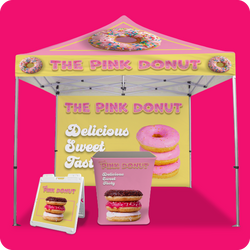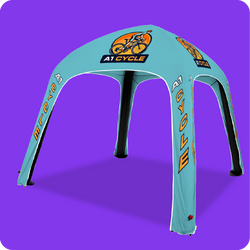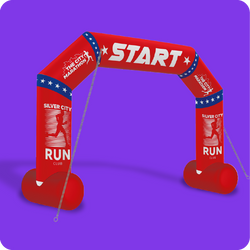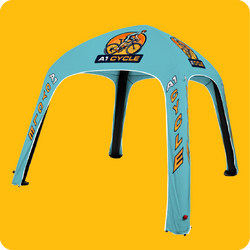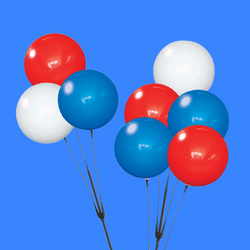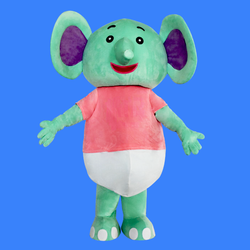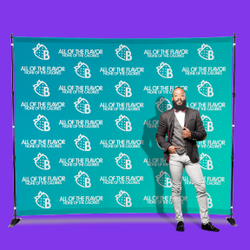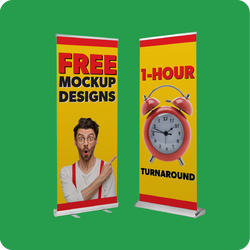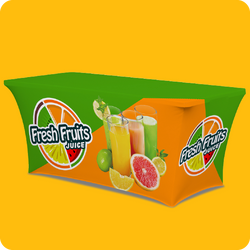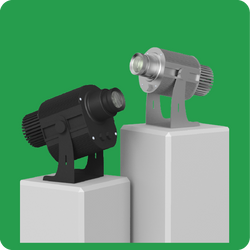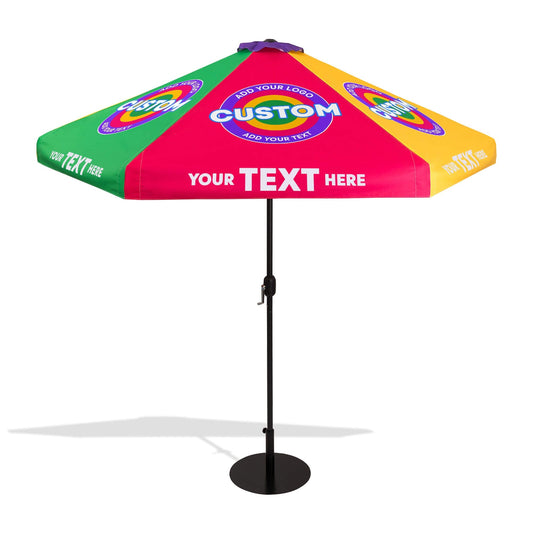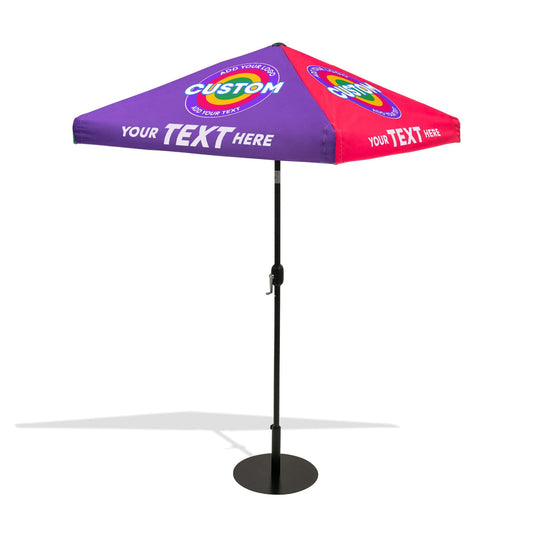Frequently Asked Questions
Custom patio umbrellas come in various sizes to suit different outdoor spaces and needs. The available sizes for personalized patio umbrellas can vary between the shape but here are the most common sizes:
6-Foot Patio Umbrella: This size is suitable for small bistro sets, intimate seating areas, or compact patio spaces.
7.5-Foot Patio Umbrella: A popular size that provides a bit more coverage than the 6-foot version, making it suitable for standard patio tables and larger seating areas.
9-Foot Patio Umbrella: This size is one of the most common and versatile options. It can cover larger dining tables or provide shade for multiple seating arrangements while showing off your logo or branding.
10-Foot Patio Umbrella: Slightly larger than the 9-foot umbrella, this size is ideal for larger outdoor dining sets and more spacious patio areas. Keep in mind that these sizes are based on the diameter of the umbrella canopy when it is fully open. When selecting a custom patio umbrella size, consider the size of your outdoor space, the area you want to shade, the number of people it needs to accommodate, and the style and aesthetics that best complement your outdoor setting. Custom patio umbrellas give you the flexibility to choose the perfect size and design that suits your specific needs and preferences.
Yes, custom patio umbrellas often come with the option to include a base. The base is an essential component of a patio umbrella setup as it provides stability and support, keeping the umbrella securely in place. The type and size of the base can vary depending on the design and specifications of the custom patio umbrella. Here are some common types of umbrella bases that may be available with custom patio umbrellas:
Standard Base: This is a simple and commonly used umbrella base made of materials like plastic, concrete, or steel. It usually has a compact and straightforward design, suitable for smaller patio umbrellas.
Weighted Base: Some umbrella bases come with a built-in weight or the option to add weight, such as sand or water, to increase stability. Weighted bases are ideal for areas with moderate wind conditions.
Freestanding Base: Freestanding bases are self-supporting and don't require additional support from a patio table. They provide more placement options and are suitable for standalone use.
Table Insert Base: Some patio umbrellas are designed to be inserted into the center hole of a patio table, and the table itself acts as the support base.
When ordering a custom patio umbrella, you can often select the type and size of the base that best suits your needs. The choice of the base will depend on factors such as the size of the umbrella, the wind conditions in your area, the type of outdoor flooring, and whether you want a portable or permanent setup. If you're considering a custom patio umbrella, be sure to inquire about the available base options and choose one that provides the necessary stability and complements the overall aesthetic of your outdoor space.
Yes, custom patio umbrellas are designed to be water-resistant. They are intended for outdoor use and are exposed to various weather conditions, including rain. To ensure their durability and longevity, custom patio umbrellas are usually made from materials that can withstand moisture and are treated to be water-resistant. The canopy fabric of personalized patio umbrellas is commonly made from materials like polyester, acrylic, or olefin, which are known for their water-resistant properties. These materials are designed to repel water, preventing it from seeping through the fabric and keeping the area underneath the umbrella dry during light rain or drizzles. It's important to note that while custom patio umbrellas are water-resistant, they may not be completely waterproof. In heavy or prolonged rainfall, some water may eventually penetrate the fabric, especially if the umbrella is not tilted or properly maintained.
To maximize the water resistance of your patio umbrella, follow these tips:
Tilt the Umbrella: Most patio umbrellas come with a tilting mechanism that allows you to angle the canopy to one side. Tilting the umbrella during rain helps water run off the canopy instead of collecting on top.
Use a Protective Cover: When the patio umbrella is not in use, consider covering it with a protective cover to shield it from the elements and extend its lifespan.
Keep the Umbrella Clean: Regularly clean your patio umbrella to remove dust, debris, and mildew, which can affect its water resistance.
Store it During Harsh Weather: If you expect heavy rain or storms for an extended period, it's a good idea to store the patio umbrella indoors or in a protected area.
Remember that the level of water resistance can vary based on the quality of the umbrella and its materials. When selecting a custom patio umbrella, inquire about its water-resistant properties and maintenance recommendations to ensure it meets your needs and performs well in various weather conditions.
The time it takes to make and ship a custom-printed patio umbrella can vary depending on several factors, including the complexity of the design and the shipping method chosen. Typically, the process can be broken down into the following steps:
Design and Approval: The initial step involves creating or providing the custom design for the patio umbrella. This can be artwork, logos, graphics, or any other personalized elements. The time required for this step depends on how quickly you can finalize and approve the design.
Production: Once the design is approved, we will begin the production process. The production time in most cases can take one to two weeks.
Quality Control: The custom-printed patio umbrella undergoes a quality control process after production to ensure that the print matches the approved design.
Shipping: Shipping times can range from a few days for domestic shipping to several weeks for international shipments.
Please clarify your deadline with our team so that we can ensure it is delivered on time. Considering these steps, the overall time to make and ship a custom printed patio umbrella can vary from around 1 to 2 weeks, but it's essential to check in with us for a more accurate estimate. If you have a specific deadline or event date, it's advisable to place your order well in advance to allow for any unforeseen delays and to ensure your custom patio umbrella arrives on time.
When ordering a custom printed patio umbrella, be sure to inquire about the production timeline and provide any necessary information promptly to expedite the process.
Yes, printed umbrellas can fade over time when exposed to the sun's UV rays. The extent of fading depends on several factors, including the quality of the printing process, the type of ink used, the material of the umbrella canopy, and the intensity of sunlight the umbrella is exposed to.
Here are some factors that contribute to fading:
Quality of Printing: Higher-quality printing methods, such as dye-sublimation printing or UV-resistant inks, are more resistant to fading compared to lower-quality printing techniques.
Type of Ink: UV-resistant or fade-resistant inks are specifically designed to withstand exposure to sunlight and are less likely to fade quickly.Material of the Canopy: The material of the umbrella canopy plays a significant role in how well the printed design withstands fading. Fabrics that are treated with UV inhibitors or have high UV resistance are more likely to retain their color and vibrancy over time.
Intensity and Duration of Sun Exposure: The more intense and prolonged the exposure to sunlight, the higher the likelihood of fading. Umbrellas that are frequently exposed to strong sunlight for extended periods may experience fading faster.
To help extend the life of a printed umbrella's design and reduce fading, consider the following tips:
Choose High-Quality Printing: Opt for umbrellas with high-quality printing methods and UV-resistant inks to ensure better color retention.
Select UV-Resistant Fabrics: Look for umbrellas made from materials with UV inhibitors or high UV resistance to protect the printed design from sun damage. Use a Protective Cover: When the umbrella is not in use, cover it with a protective cover to shield it from direct sunlight and the elements.
Store Indoors: Whenever possible, store the umbrella indoors or in a shaded area to minimize sun exposure when not in use.
Regular Cleaning: Clean the umbrella canopy regularly to remove dirt, dust, and pollutants that can contribute to fading. While printed umbrellas will likely experience some degree of fading over time due to sun exposure, taking these precautions can help prolong the vibrancy and lifespan of the printed design.
The lifespan of printed umbrellas can vary depending on several factors, including the quality of the printing, the materials used, how well they are cared for, and the conditions they are exposed to. On average, a well-maintained and high-quality printed umbrella can last anywhere from 2 to 5 years or more.
Here are some factors that can influence the longevity of printed umbrellas:
Printing Quality: Higher-quality printing methods, such as dye-sublimation or screen printing with fade-resistant inks, tend to have better color retention and can withstand fading from UV exposure for a longer time.
Material Quality: The quality of the umbrella's fabric or canopy material is crucial in determining its durability. Fabrics treated with UV inhibitors or designed to be UV-resistant will hold up better against sun exposure and other environmental factors.
Weather Conditions: The climate and weather conditions in the umbrella's location can impact its lifespan. Excessive exposure to harsh sunlight, rain, wind, or other extreme weather conditions can accelerate wear and tear.
Maintenance: Regular cleaning and proper care can help extend the lifespan of the printed umbrella. Keeping the umbrella clean and dry when not in use, using protective covers, and storing it in a protected area during harsh weather can make a difference.
Frequency of Use: How often the umbrella is used can also affect its longevity. Frequent use and exposure to the elements will naturally wear out the umbrella faster than occasional use.
Usage Environment: The environment in which the umbrella is used can influence its lifespan. For example, umbrellas used in commercial settings, such as restaurants or outdoor events, may experience more wear and tear compared to those used in private residential settings.
Keep in mind that the lifespan of printed umbrellas is an estimate and can vary depending on the specific circumstances. Regularly inspecting the umbrella for signs of wear and fading and addressing any issues promptly can help maximize its lifespan.





